Buffel grass: Don't blame (only) the CSIRO
14 May 2018
Archived article
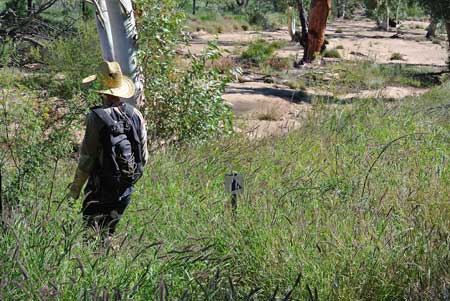 By DES NELSON OAM
By DES NELSON OAM
Having recently heard the sometimes repeated view that the CSIRO was responsible for the invasion of Buffel grass in Central Australia, I would like to present some observations of my own. I do not write of hearsay. I had first-hand experience of all places and events described here.
In the early 1950s I observed a fairly large stand of small black-headed Buffel grass near Barrow Creek. This strain also occurred patchily along the banks of the Todd River. It was a minor part of the vegetation. I believe this may have been the Buffel historically accepted as having been introduced during the era of camel transport in the 19th century, either accidentally from stuffing from worn saddles, or deliberately planted. It is hard to find, these days.
After World War 2, the cattle industry was deemed to be of maximum importance to the prosperity of Central Australia. Much effort was expended to improve it. Pasture improvement was one category to be promoted.
Some cattle stations were provided with bulk quantities of Buffel grass seed, I believe by the Federal Government, before any works by CSIRO or other departments were developed.
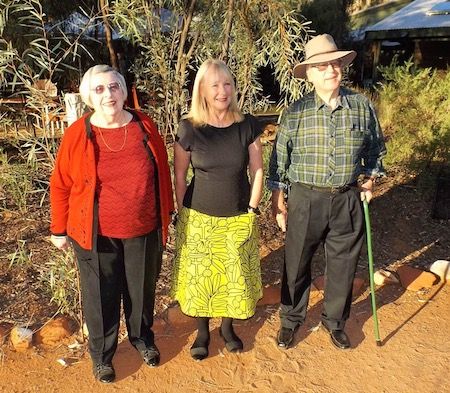 In the workshop of a station on which I was a teenage jackaroo in the early 1950s, was a room full of chaff-bags of such Buffel seed. When I did a bore run I carried a bag of seed in my truck and threw out hands-full as I drove. A primitive method but it did work to a minor degree.
In the workshop of a station on which I was a teenage jackaroo in the early 1950s, was a room full of chaff-bags of such Buffel seed. When I did a bore run I carried a bag of seed in my truck and threw out hands-full as I drove. A primitive method but it did work to a minor degree.
CSIRO was established on a permanent basis in Alice Springs with the arrival of Bob Winkworth in 1953. “Winky” travelled widely in the district learning the country, meeting the people and studying the flora and hydrology of the region.
Later, he established study sites in the bush and began work on a small paddock on the Arid Zone Research property, commonly known then as the Animal Industry Branch, or AIB Farm. Here, small plots of proposed pasture plants were sown, among them strains of Buffel.
The work began in 1960, by which time we were into the third year of a terrible drought. The little plots had to be irrigated to survive. In 1958, the first year of the eight year drought, a small exclosure had been built just south of Alice Springs airport. Here deep ripping had been done on a clay-pan and Buffel seed sown into the deep trenches. Known as the “Scald site”, the drought ensured it would fail.
Local conditions became very grim as the drought progressed. Much of the countryside was completely denuded of ground cover in the pastoral areas. On field trips I found it better to travel into sand-dune desert country which was free of dust, while Alice Springs was enduring massive, towering dust storms. Cattle were starving and dying.
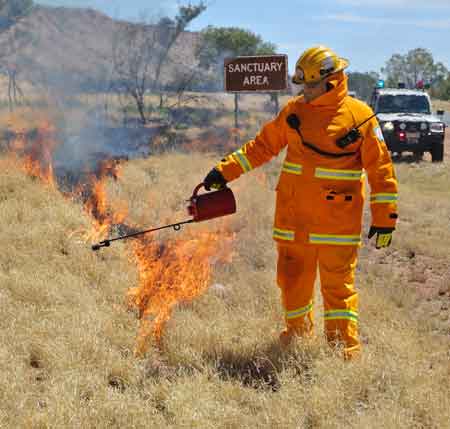 Turboprop and pure jet passenger aircraft had replaced piston engine craft by this time. Their engines were more sensitive to the effects of dust laden air.
Turboprop and pure jet passenger aircraft had replaced piston engine craft by this time. Their engines were more sensitive to the effects of dust laden air.
Two schemes were promoted by officers of the Northern Territory Government. One was to establish some pasture to enable the cattle industry to survive. The other was to eliminate dust for the airline industry to survive.
Now came a period of great activity. A dust exclusion zone was declared, mainly to the south of Alice Springs; then came large-scale planting of Buffel grass, not just on the dust exclusion zone but on many of the Centre cattle stations. Two tractor towed machines were used, the Paech pitter and the opposed disc plough. Clay-pan areas were ploughed and planted in a spiral pattern, visible clearly from the air today.
To assist these programs a variety trial was established by the NT Government in the Quarantine paddock, south-west of Alice Springs. There, in the 1970s, six strains of Buffel, plus Birdwood grass were extensively planted in rows, four runs for each strain.
[ED – The Northern Territory received Self Government in 1978. Prior to that it was governed by the Commonwealth.]
When the grasses had become well established, cattle were released into the area, enabling observation as to which of the grasses were preferred for grazing. The seed of the three most preferred strains were used in planting many thousand hectares of pastoral country.
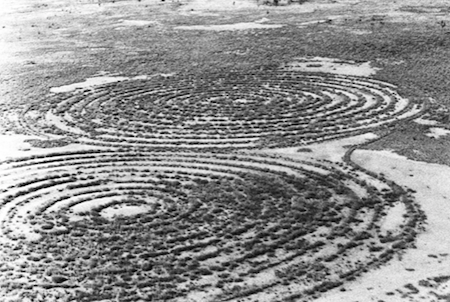 There is speculation that a specific Central Australian strain of Buffel grass originated from trial plantings of adjacent strains. The extensive plantings in the Quarantine paddock would be the most likely place of origin of such a strain.
There is speculation that a specific Central Australian strain of Buffel grass originated from trial plantings of adjacent strains. The extensive plantings in the Quarantine paddock would be the most likely place of origin of such a strain.
The mechanical sowing of Buffel by the Land Conservation unit of the Conservation Commission of the NT was a huge success and without doubt, along with a series of above average rainfall years, has given us the Buffel landscape we have today.
Part of the success of Buffel may be due to the fact that plant breeders have produced strains that are specifically Australian. There are many Australian developments such as the Kelpie and Blue Heeler dog; there are Australian cattle breeds; the renowned Waler horse; Australian chooks; Federation wheat; and so on. So, with Buffel we have strains like Biloela, Gayndah, West Australian and others.
It is hard to describe to those who did not experience it the conditions during the 1958-65 drought.
Thousands of kilometres of utterly bare ground. Every breeze blew dust. Colossal dust storms reduced visibility to nil.
 I did much field work during this period. One morning I awoke to find my swag half buried in drift. On another occasion I drove to a photo site 80 km south-east of town to find a fence there had been buried by moving sand.
I did much field work during this period. One morning I awoke to find my swag half buried in drift. On another occasion I drove to a photo site 80 km south-east of town to find a fence there had been buried by moving sand.
To the north of town I spoke to a station manager whose job then was to drive around, shooting cattle which were too weak to walk.
I never imagined beasts would become so thin, looking almost like cardboard cut-outs. You could push them over from the side. They were too weak to rise again.
No wonder that the belief that some saving pasture could remedy things was so widespread. Buffel grass was believed by pastoralists and scientists to be the answer. If some of those who are here today were living during those devastating conditions, they would have agreed.
Only one professional person in my memory spoke against the sowing of Buffel. When asked what he thought about it, botanist George Chippendale said: “I don’t think it is a good idea.”
Reclamation work took place in selected areas during the drought. One such place was the former Simpsons Gap Station. Limited area, rugged terrain, limited pasture, grazing livestock and rabbits reacted together to leave the place denuded and eroded by wind and water. CSIRO helped with earthworks, and Buffel seed was sown.
 South of Simpsons Gap, White Gums Station also suffered, but careful management had kept the landscape in a less eroded state. The Yeoman’s Keyline system was employed to promote pasture growth that included Buffel grass. Much of the effort was frustrated by rabbit grazing. We had a serious problem with rabbits in some places in the Centre, contributing to vegetation damage.
South of Simpsons Gap, White Gums Station also suffered, but careful management had kept the landscape in a less eroded state. The Yeoman’s Keyline system was employed to promote pasture growth that included Buffel grass. Much of the effort was frustrated by rabbit grazing. We had a serious problem with rabbits in some places in the Centre, contributing to vegetation damage.
Rabbits contributed greatly to the removal of ground cover at Uluru. The gorges around The Rock were bared. Conservation Commission got to work with its machinery sowing Mutitjulu Gorge with Buffel, with eventual spectacular success.
Although it was hoped that Buffel grass would become a useful part of the ground vegetation, few realised that it would reach its current dominance, particularly on hill-sides, alluvial, and calcareous soils.
Before CSIRO arrived on the local scene, two Browns sowed Buffel on their properties in the 1950/51 seasons. Burge Brown on Murray Downs, 400 km NE of Alice Springs and Jim Brown on White Gums near Honeymoon Gap.
My personal opinion of Buffel is ambivalent. If I were a pastoralist I am sure I would encourage it. Otherwise, I am saddened by the effect on places where it is so dominant that it is a serious fire hazard and has eliminated large areas of wildflowers.
In my sixty-five years of bush observations in the Centre, 1967-68 was the time of most profuse and widespread growth of wildflowers. With the covering of Buffel, such a display will not occur to the same extent.
Tests with a radiometer were made in the rural residential area just south-east of Alice Springs in 1990. These showed that shading of the ground under Buffel tussocks was about equivalent to that of night time, effectively reducing the chances of other species competing for light, as well as nutrients.
Buffel grass is here to stay. It is not my intention to discuss here what means can be used in its control but I do have opinions. I will mention that by sheer hard work, personnel at the Alice Springs Desert Park have done a wonderful job in eliminating Buffel from their domain.
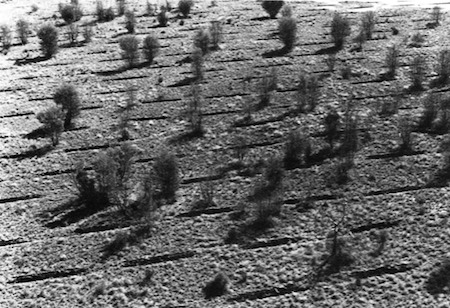 If you want to see a piece of local country looking as it should, have a look at the Desert Park landscape. How ironic it is that the work done there was performed by the Parks and Wildlife Commission of the NT, the direct descendant of Conservation Commission of the NT whose Land Conservation unit was largely responsible for the very successful spread of Buffel grass in Central Australia.
If you want to see a piece of local country looking as it should, have a look at the Desert Park landscape. How ironic it is that the work done there was performed by the Parks and Wildlife Commission of the NT, the direct descendant of Conservation Commission of the NT whose Land Conservation unit was largely responsible for the very successful spread of Buffel grass in Central Australia.
It can be seen that the part played by CSIRO was not the major one, by a long shot, for the Buffel grass invasion.
While on the subject of the defence of CSIRO, this would be a good place to lay to rest another furphy, the ridiculous claim that the organisation (then CSIR) was responsible for the introduction of what we refer to as Cane Toads, into Australia.
The facts, gleaned from “Cane Toads”: Editor Karl Weber, Public Affairs 2010 are: “With the approval of Commonwealth Director-general of Health, Dr John Crumpton, and with the sanction of the Premier of Queensland and the Australian Prime Minister, the director of the Queensland Bureau of Sugar Experiment Stations, William Kerr arranged for Entomologist Reg Mungomery to sail to Hawaii in April 1935 to collect 102 toads.
“The first release, of 2400 toads took place into the Gordonvale, Queensland area on August 19, 1935.
PHOTOS: Buffel-choked creekbed in the West MacDonnells • Des and Pat Nelson with Gillian Ward (centre), author of Olive Pink: Artist, Activist & Gardner, at Olive Pink Botanical Gardens which has fought a long war against buffel, photo by Alex Nelson. • Burning buffel • Two buffel spirals south of the Alice Springs Airport, covering about one hectare • Scalded surface (April 1967) in the Todd Land System • Severe scalding and drift in the Finke Land System, March 1966 • Newly ploughed staggered furrows • (B&W photos from the archive of ALEX NELSON.)



The Desert Park is by no means buffel free.
Even after thousands of hours of eradication work buffel thrives in places.
Buffel produces so many wind borne seeds that constant work is needed to control it.
Interesting to learn that the Brown Family were early introducers of the weed that now threatens the entire landscape.
Balanced authoritative article. Probably the best so far written on the subject.
The Brown family are very proud of both their association with, and their assistance too, the CSIRO in its efforts to improve pasture and control dust in Central Australia.
The beef industry was then, and is now, a very important part of our economy making improved pasture an enormous benefit to all of us.
Yes, there are management issues in places where buffel is not grazed, especially given the irresponsible and destructive culture of burning as opposed to grazing that has been developed by Government authorities.
However, in the pastoral industry buffel is of huge benefit lifting the carrying capacity of the country enormously while simultaneously improving our soils, slowing run off, suppressing dust and vastly extending the length of grazing period gained from any rainfall event.
In short, there is simply no comparison between this country in the fifties and sixties and what you see and experience today.
When I grew up over those years the country was so bare you wouldn’t believe anything could survive on it.
Huge dust storms were the norm, you could drop a match (as was the practice) in a spinifex bush without the slightest danger of the fire spreading as there was nothing for the flames to spread to. There were also many fewer trees and shrubs than you see today which meant you could see something coming kilometres further away than you can now.
Through it all, Centralian families struggled to produce something, to build a future, to bring a level of prosperity and belief to a place other Australians then referred to as the “Dead Heart of Australia”.
Well nobody uses that term today, and a large part of that is due to the efforts of those who along with the CSIRO and other government bodies such as the AIB and Agricultural Branch who fought so successfully to bring life to the Centre, improving our amenity, making the place more liveable and more accessible by modern aircraft, increasing tourism, upping our productivity – all this through the introduction of improved pasture.
It’s the whim of some to winge constantly about the nuisance side of improved pasture like buffel, – that’s your right but please keep it in perspective.
Improved pastures as opposed to natural or native pasture is the farming practice used right around the world and right around Australia to vastly increase our ability to produce food, making it possible for you eat and survive even at the vast population levels of today, levels which will apparently double in the next 40 years.
Yes, there is a price to pay, just as when you put a ship upon the ocean, build a town a dam or road but without these things we could not sustain our population.
Some, of course, would argue that would be a good thing, but we never see them volunteering not to eat anymore, do we?
People are quite willing to accept the resultant lifestyle afforded by these improvements but are ever ready to condemn those who had a hand in the conception of such when public opinion changes.
Your pasture, Steve, is spreading and causing huge damage to the environment and biodiversity. Your justification of feeding hungry people doesn’t stack up either.
Plant foods produce so much more food per area than beef ever will.
This is a noxious weed south of the border and north as well.
Can we get some of those buffle eating caterpillars over from Queensland before it spreads and ravages more native plant communities.
It’s sad that the same effort has not gone into legumes that are native to this area as a meant of maintaining soil fertility and rural productivity as happened with the stylo, Phaseolus and Leucauna families in Queensland.
It is interesting to note that a year or two ago Leucaena was described as a wonder plant around Kununurra. Yet we planted up areas of Fiji with this plant 40 years ago.
The research into alternatives to buffel has been abysmal. There is currently much research going on into our native Acacias but all being done overseas.
The last effort to investigate the benefits of soil microbiology in our area happened in 1983 with a small Mycorriza (soil fungi which release nutrients to other plants) project in the Top End.
Yet WA has made major advances in arid zone microbiology research and productivity and at one stage was looking for research from here with no success.
All this should have been on public display at AZRI but other short term concepts prevailed.